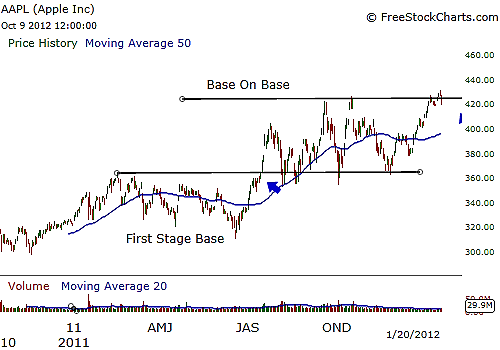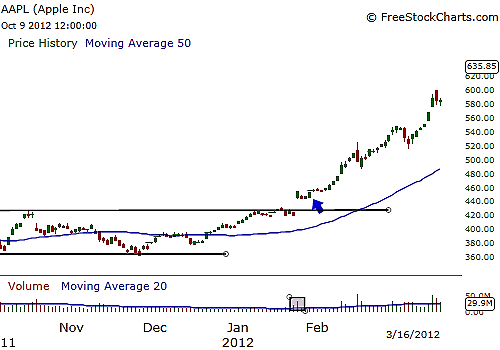
HOT TOPICS LIST
- MACD
- Fibonacci
- RSI
- Gann
- ADXR
- Stochastics
- Volume
- Triangles
- Futures
- Cycles
- Volatility
- ZIGZAG
- MESA
- Retracement
- Aroon
INDICATORS LIST
LIST OF TOPICS
PRINT THIS ARTICLE
by Billy Williams
As a rule, the market doesn't give many second chances after a runaway move occurs but, if you know these key setups, you could be the exception.
Position: Hold
Billy Williams
Billy Williams has been trading the markets for 27 years, specializing in momentum trading with stocks and options.
PRINT THIS ARTICLE
STRATEGIES
Second Chances And Pyramiding
10/11/12 08:40:20 AMby Billy Williams
As a rule, the market doesn't give many second chances after a runaway move occurs but, if you know these key setups, you could be the exception.
Position: Hold
| When price breaks out of a first-stage base pattern, it has the potential to gain a quick 25% price target, provided that all the key factors are in place such as trading with the overall market, volume levels are met at the moment of the breakout, bought at the proper place within the chart pattern, and the stock's fundamental profile is strong to attract followers, particularly the heavy hitters -- the institutional traders. However, it can be a challenge to calculate the various criteria leading up to and during the breakout move, making this pivot buy point in the first-stage base pattern the hardest to time properly (Figure 1). That said, there are secondary opportunities to buy or add to a position if you understand what they are and how to do both intelligently and skillfully. Fortunately, this is not that hard once you understand the setups and the rules to navigate the market once a stock has made its breakout move. |

|
| FIGURE 1: AAPL. On July 18, 2011, AAPL broke out for its first-stage base and then formed a base on base pattern, giving you a chance for a second entry as the stock climbed higher. |
| Graphic provided by: www.freestockcharts.com. |
| |
| When a stock signals an entry after a breakout occurs, there can be a brief moment where price stalls and/or pulls back briefly. This is especially true if the stock breaks higher through the pivot buy point on a price gap. In the book "Technical Analysis Of Gaps," it shows that an exhaustive study was done on breakout moves where a price gap occurred and, most of the time, price would pull back briefly before going higher. This edge is important because after an initial breakout, you can still enter the move within 5% of the pivot buy point. It is within this price zone that you can add to an existing position and/or still catch the move by entering a position that is within this range. |

|
| FIGURE 2: AAPL. On January 25, 2012, price broke higher out of the base on base pattern with a huge price gap. As studies show, gaps on a breakout tend to pull back, which gives you a chance to take a position, or add to an existing one, at a great entry point. |
| Graphic provided by: www.freestockcharts.com. |
| |
| If you still manage to miss entering the move, don't lose hope because you can still enter on the formation of another base pattern. First-stage and secondary base patterns are still valid entry points and it is common for secondary base patterns to form after the initial breakout. Price tends to consolidate at new highs after the breakout as investors and traders adopt a "wait-and-see" attitude on future earnings or other fundamental criteria in order to gauge the future prospects of a stock's price movement. See Figure 2. As the secondary base pattern forms, it should form over a four- to eight-week time period and the pivot buy point should be over the intraday price high established during that time frame. One word of warning, though: third and fourth base patterns should be avoided as they are unreliable and price tends not to trade much higher before reversing. |
| Finally, trading off the 50-day simple moving average (SMA) is a valid signal to buy into a move or add to an existing position. Price will pull back and use the 50 SMA as support before resuming its upward price movement where you could enter off the resumption of the trend and/or the previous price high set before price tested the 50 SMA. Adding to a winning position holds the promise of big profits, but it is critical that you recalculate your position size and risk level. If you understand the risk and have a method of trade management that allows you to adjust when the trend is in your favor, then you have the right tools to score enormous gains. If you don't, then don't worry about adding to your position, but if you master the fundamentals like using these setups as a means to gain entry into a moving stock when you miss the initial breakout, you'll come out ahead. |
| Only after you use these tools often enough do you want to even consider pyramiding your positions. Remember, successful trading isn't an event, or big score; it's a steady series of doing the right things each day, every day, and eliminating bad mistakes like rushing in too quickly and too big before you're ready. |
Billy Williams has been trading the markets for 27 years, specializing in momentum trading with stocks and options.
| Company: | StockOptionSystem.com |
| E-mail address: | stockoptionsystem.com@gmail.com |
Traders' Resource Links | |
| StockOptionSystem.com has not added any product or service information to TRADERS' RESOURCE. | |
Click here for more information about our publications!
PRINT THIS ARTICLE

|

Request Information From Our Sponsors
- StockCharts.com, Inc.
- Candle Patterns
- Candlestick Charting Explained
- Intermarket Technical Analysis
- John Murphy on Chart Analysis
- John Murphy's Chart Pattern Recognition
- John Murphy's Market Message
- MurphyExplainsMarketAnalysis-Intermarket Analysis
- MurphyExplainsMarketAnalysis-Visual Analysis
- StockCharts.com
- Technical Analysis of the Financial Markets
- The Visual Investor
- VectorVest, Inc.
- Executive Premier Workshop
- One-Day Options Course
- OptionsPro
- Retirement Income Workshop
- Sure-Fire Trading Systems (VectorVest, Inc.)
- Trading as a Business Workshop
- VectorVest 7 EOD
- VectorVest 7 RealTime/IntraDay
- VectorVest AutoTester
- VectorVest Educational Services
- VectorVest OnLine
- VectorVest Options Analyzer
- VectorVest ProGraphics v6.0
- VectorVest ProTrader 7
- VectorVest RealTime Derby Tool
- VectorVest Simulator
- VectorVest Variator
- VectorVest Watchdog
